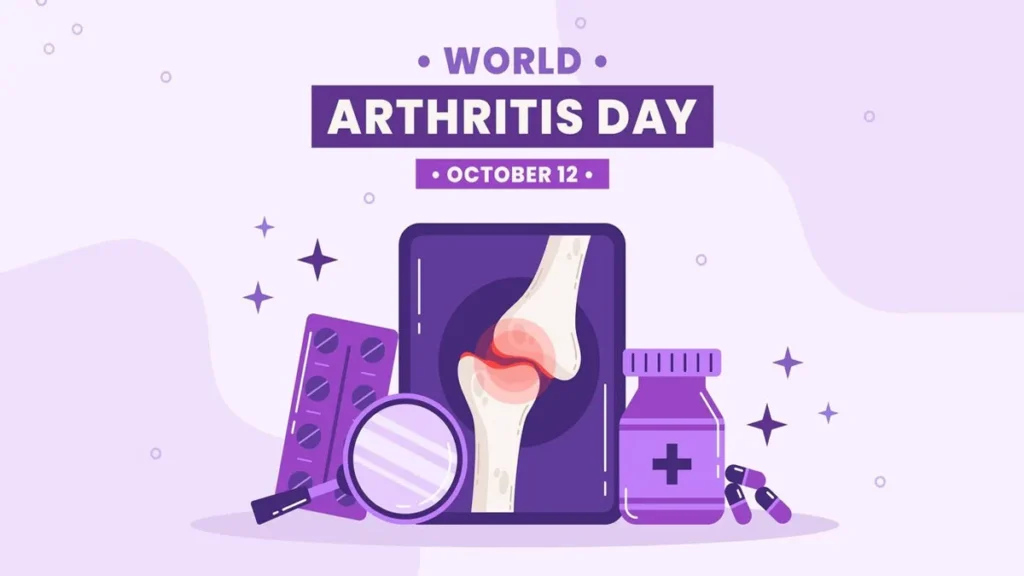
-1728581369941.webp)
One of the most pressing health issues of our time is arthritis, which is no longer restricted to the elderly as was once thought. Young adults are being diagnosed with various forms of arthritis, which is frequently linked to changes in lifestyle, autoimmune disorders, and increased joint stress from modern life. The condition is a major cause of disability worldwide because it affects mobility, independence, and overall quality of life in addition to causing pain and stiffness. World Arthritis Day, which is observed annually, plays a crucial role in raising awareness, promoting early diagnosis, and encouraging both effective treatment and prevention. We will discuss the significance of World Arthritis Day 2025, its theme, common symptoms, available treatments, prevention strategies, and how Graphic Era Hospital in Dehradun is supporting patients in managing arthritis with comprehensive care in this article. Why is it celebrated on World Arthritis Day? On October 12 each year, World Arthritis Day is observed to raise awareness of arthritis and other rheumatic diseases that affect millions of people worldwide. The day was started in 1996 by the European Alliance of Rheumatology Associations (EULAR). Since then, it has grown into a global movement that brings together patients, families, healthcare professionals, and advocacy groups. Beyond raising awareness, World Arthritis Day serves a greater purpose. It brings to light the difficulties that arthritis sufferers face, promotes access to effective treatment and rehabilitation, and encourages early screening and diagnosis. It is important to note that young adults and even children are increasingly being diagnosed with inflammatory and lifestyle-related forms of arthritis. This demonstrates that arthritis is no longer confined to the elderly. By commemorating Arthritis Day, societies and healthcare organizations worldwide reaffirm their commitment to promoting joint health, reducing disability, and assisting arthritis sufferers to lead active, fulfilling lives. More on Osteoporosis: Causes, Early Warning Signs, and Treatment World Arthritis Day’s 2025 Theme “Achieve Your Dreams” will be World Arthritis Day 2025’s official theme. People who are afflicted with arthritis and other rheumatic and musculoskeletal diseases (RMDs) are highlighted by this theme in terms of their aspirations, aspirations, and resilience. It demonstrates that despite the difficulties of living with arthritis, people can continue to pursue their goals with prompt diagnosis, efficient treatment, and the appropriate support systems. Patients are urged to share their personal stories and aspirations in the campaign, which also appeals to healthcare professionals, policymakers, and communities to guarantee access to better resources and care. The theme promotes optimism and reminds society that arthritis patients can benefit from collective action by focusing on possibilities rather than limitations. What are the initial symptoms and signs of arthritis? Recognizing the early warning signs of arthritis is essential for prompt diagnosis and treatment. Arthritis frequently progresses over time. Although the symptoms of arthritis can vary, some common indicators include: Chronic pain: Persistent joint pain, especially in the knees, hips, hands, or spine, is one of the earliest symptoms. The pain may worsen with activity or towards the end of the day.
Swelling: Swollen, warm to the touch, or tender joints are signs of underlying inflammation. Stiffness: A common symptom of inflammatory arthritis, such as rheumatoid arthritis, is morning stiffness that lasts longer than 30 minutes. Skin redness: Active inflammation may be indicated by visible redness or warmth in some joints. Limited range of motion: The onset of arthritis may be indicated by the inability to move joints freely or by reduced flexibility when performing everyday activities like walking or climbing stairs. Find out more about tennis elbows here. Which kinds of arthritis are there? Arthritis is not one disease; rather, it is a collection of disorders that each have different effects on the joints. The following kinds of arthritis can assist in identifying symptoms and seeking appropriate treatment: OA, or osteoarthritis OA, also known as wear-and-tear arthritis, is a condition in which the protective cartilage that covers the ends of the bones deteriorates over time. It typically causes stiffness, swelling, and pain in the knees, which are the weight-bearing joints. Arthritis Rheumatoid (RA) An autoimmune condition known as rheumatoid arthritis occurs when the immune system mistakenly attacks the lining of the joints. If not treated promptly, this can cause joint deformity, inflammation, and long-term disability. Smaller joints, like those in the hands and feet, are frequently affected. Arthritis with Viruses This type of arthritis, which is also known as septic arthritis, is brought on by bacterial, viral, or fungal infections that spread to the joint. It occurs suddenly, causes severe pain, swelling, and fever, and necessitates immediate medical attention. Metabolic arthritis, or gout, Gout is caused by crystallization of uric acid in the joints, typically in the big toe. It causes sudden, severe episodes of pain, redness, and swelling, sometimes referred to as “gout attacks.”
How is arthritis determined and treated? An accurate diagnosis is essential to the success of arthritis treatment. A combination of clinical evaluation, medical history, and diagnostic tests are used by physicians to confirm arthritis because joint pain can be caused by a variety of conditions. Clinical assessment The affected joints are examined by a doctor who treats joint pain for swelling, warmth, redness, and range of motion. Additionally, they might check for tenderness and stiffness to determine the condition’s severity. Anatomy and pathology The duration of symptoms, family history, lifestyle habits, and previous injuries all contribute to the identification of arthritis risk factors. Test of diagnostics In rheumatoid arthritis, blood tests are used to look for signs of inflammation, infections, or autoimmune activity. X-rays, ultrasound, and MRI scans are imaging tests that show damage to joints, changes in the bone, and the loss of cartilage. Alternative treatments Medications: Anti-inflammatory, painkilling, and disease-modifying medications are frequently prescribed for RA. Physiotherapy and rehabilitation: aids in reducing stiffness, strengthening supporting muscles, and improving mobility. Modifications to one’s way of life: reducing joint pressure through regular exercise, a healthy diet, and controlling one’s weight. Options for surgery: Joint replacement or corrective surgery may be necessary in severe cases. Which are the most effective lifestyle recommendations and home remedies for arthritis? While seeking medical attention is essential, making minor adjustments to one’s way of life and using home remedies can have a significant impact on relieving arthritis pain and enhancing joint health. These measures assist patients in remaining active and comfortable in daily life when combined with treatment. Dietary tips, exercises, and physiotherapy techniques that can help improve joint health and provide long-term relief are discussed in the following sections: Nutrition and diet for joint health Joint pain and swelling may be reduced by eating foods with anti-inflammatory properties like turmeric, ginger, garlic, leafy greens, and fish or flaxseeds. Dairy products, ragi, and cereals with added calcium and vitamin D support bone health and mobility. The suggested exercises Walking, yoga, and swimming are examples of low-impact activities that improve flexibility and reduce stiffness. Additionally, strengthening the muscles around the joints prevents further damage. Physiotherapy to treat arthritis By enhancing muscle strength, mobility, and posture, physiotherapy aids in arthritis management. Personalized physiotherapy and rehabilitation programs are created at Graphic Era Hospital, Dehradun, to alleviate pain and promote long-term joint health. How can we slow the progression of arthritis or prevent it? While there is no way to completely avoid arthritis, especially when it is brought on by aging or genetics, good habits can lessen the likelihood of developing it and slow its progression. Long-term joint health is greatly impacted by preventative care, such as: Healthy weight control Weight-bearing joints like the hips and knees are put under additional stress by excess body weight. The likelihood of developing osteoarthritis is decreased and strain is reduced by maintaining a healthy weight. Preventing joint damage Preventing premature wear and tear on joints during sports, exercise, or everyday activities is helpful. Simple but effective measures include lifting heavy objects correctly and wearing supportive footwear. Prevention and early detection Early detection of symptoms like stiffness or persistent pain in the joints allows for prompt treatment. Seeing a rheumatologist or orthopaedic doctor on a regular basis can help find arthritis early, when treatment is most effective. Read More: The Advantages and Recovery Time of Minimally Invasive Procedures How is World Arthritis Day observed in India and around the world? In order to raise awareness and encourage early care, the day brings together communities, advocacy groups, and healthcare organizations. In order to educate people, provide assistance to patients, and emphasize the significance of joint health at every stage of life, campaigns and activities are held in a variety of settings. Some common things to do are: Sensitization Campaigns Public talks, educational drives, and campaigns on social media spread information about the early signs of arthritis, ways to prevent it, and how important it is to get a diagnosis quickly. Camps for health checks and events at hospitals To make it easier for patients to get a diagnosis and advice from specialists, hospitals and medical centers hold free screening camps, seminars, and patient support sessions.




